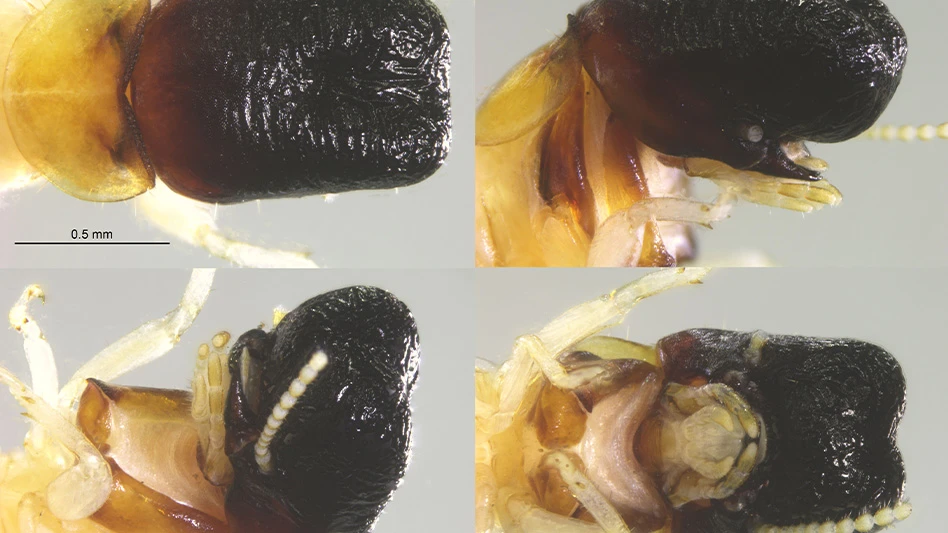 Bed bugs have long been drenched and dusted with insecticides. While toxicants were more typically applied as liquids, infested beds and belongings also were dusted with such materials as sulfur, pyrethrum and 10 percent DDT powder. Without a simple one-shot solution, companies are again employing dusts in their bed bug management programs.
Bed bugs have long been drenched and dusted with insecticides. While toxicants were more typically applied as liquids, infested beds and belongings also were dusted with such materials as sulfur, pyrethrum and 10 percent DDT powder. Without a simple one-shot solution, companies are again employing dusts in their bed bug management programs.
Today’s dust formulations often contain pyrethroids (e.g., Tempo Dust [Bayer Environmental Science], DeltaDust [Bayer Environmental Science]) or neonicotinoids (Alpine [BASF Corp.]) as active ingredients. While such materials can be efficacious, resistance and other factors have fueled interest in dusts that kill via desiccation. (photo 1). In previous studies with diatomaceous earth, the compound performed well in the lab, but poorly in the field (Romero et al. 2009, Potter et al. 2013). The present study focuses on another dust desiccant, silica gel, evaluated in both the lab and in bed bug-infested apartments.
Understanding Silica Gel.
 Silica gels are white, fluffy, powders manufactured from silica. Silica (Si) comprises more than a quarter of the earth’s crust in the form of sand, quartz, clay and other materials. Many plants, including those we eat, absorb soluble forms of silica from soil. Silica does not occur naturally in its pure form, reacting instead with oxygen and water to form silicon dioxide (SiO2). Thus, the terms “silica” and “silicon dioxide” are often used interchangeably.
Silica gels are white, fluffy, powders manufactured from silica. Silica (Si) comprises more than a quarter of the earth’s crust in the form of sand, quartz, clay and other materials. Many plants, including those we eat, absorb soluble forms of silica from soil. Silica does not occur naturally in its pure form, reacting instead with oxygen and water to form silicon dioxide (SiO2). Thus, the terms “silica” and “silicon dioxide” are often used interchangeably.
Both silica gel and diatomaceous earth (DE) are comprised of silicon dioxide but their origins and manufacture are different. DE is mined from fossilized remains of microscopic plants (diatoms) whose hardened shells contain silica. Silica gel however is synthetically produced, often from sand, via various manufacturing processes. The term “gel” is somewhat misleading since the material is hard and often formed into beads or granules. Silica gel is also amorphous (non-crystalline), which greatly diminishes its potential hazard to humans.
Silica gel and other forms of synthetic amorphous silica have many industrial uses beyond insecticides. They are efficient desiccants (drying agents), which is why small bags of the material are often packaged with electronics to prevent moisture accumulation during shipping and storage. Due to their anti-clumping properties, silica gels are sometimes added to powdered foods, pharmaceuticals and cosmetics.
Role as Insecticides. Products containing silica gel have been used by the pest control industry for more than a half century. The first such product (Dri-Die, Fairfield American Corp.) was registered in 1956. Formulations employed for pest control tend to be light, fluffy powders comprised of very small, porous particles. The tiny particles often have an electrostatic charge that helps them adhere to insects crawling over treated surfaces. Sometimes referred to as “aerogels,” the resultant dusts can be so light that a pint-size bottle weighs just a few ounces. Because the particles are so lightweight, they often suspend in the air following application. To overcome this, some formulations contain additives such as petroleum distillate (e.g., Drione, Bayer Environmental Science), or are dispensed as liquid aerosols (Tri-Die, BASF Corp.). These two formulations also contain pyrethrins and piperonyl butoxide. Recently, another formulation (CimeXa) containing 100 percent amorphous silica gel and no other additives, was introduced by Rockwell Labs.
Mechanism of Action. Both silica gel and diatomaceous earth kill insects by removing a portion of the razor-thin, waxy outer coating that helps them conserve moisture. As a result, they desiccate and die from dehydration. Like super-fine sandpaper, DE acts principally by abrading the protective outer layer of wax as the insect crawls over or through the particles. Instead of causing abrasion, silica gel functions more like a sponge to absorb the cuticular waxes onto the particles. Silica gels have tremendous oil-absorbing capability. Studies have shown that such highly “sorptive” dusts are generally more effective than abrasive, less absorptive dusts (such as DE), especially under field conditions (Ebeling 1961, 1971; Subramanyam and Roesli 2000). It should be noted that boric acid is not a desiccant and has little effect on bed bugs since it must be ingested. None of the aforementioned dusts kill insects by clogging the breathing pores (spiracles) as is sometimes erroneously believed.
Safety Profile. Silica gel has low toxicity to mammals. The acute oral LD50 is comparable to table salt. As noted previously, the compound is routinely added to foods and pharmaceuticals to prevent clumping. With respect to inhalation hazard, an important distinction must be made between synthetically produced, non-crystalline silica gel and naturally occurring crystalline silica such as quartz dust. Inhaling tiny particles of crystalline silica as might occur during sandblasting or mining operations can cause silicosis and other chronic respiratory illnesses. This is not a concern with non-crystalline silica gel insecticides. (Authors’ note: While inhalation of crystalline silica should not be a concern with diatomaceous earth the risk is even lower with silica gel. Synthetically produced silica gel is nearly 100 percent pure non-crystalline silica. Diatomaceous earth is also largely comprised of amorphous [non-crystalline] silica, but may contain impurities, including small amounts of crystalline silica.)
As with any dusty material, airborne silica gel particles can be somewhat irritating to the eyes and respiratory tract. Due to its desiccating properties, the dust also has a drying effect on skin which can be avoided by wearing gloves or washing after use.
Laboratory Trials.
A series of experiments were conducted to evaluate effects of silica gel on bed bugs. CimeXa insecticide dust (Rockwell Labs, North Kansas City, Mo.) containing 100 percent amorphous silica gel was used in all experiments.
Lab Test #1. In this experiment, adult bed bugs from three different bed bug populations were exposed to surface deposits of either CimeXa dust, Temprid SC (ß-cyfluthrin + imidacloprid, 0.075 percent) or water alone. The populations collected from Lexington (LEX-6) and Cincinnati (CIN-TS) were previously determined to be highly resistant to pyrethroid insecticides. The third population, collected six years ago from New York (NY-1), was initially highly resistant but has since reverted to being somewhat less resistant. Twenty adult males from each population were confined individually on treated discs of black filter paper. The CimeXa dust was applied with a small hobby brush, leaving a fine, barely visible deposit on the black paper surface. Discs wetted with Temprid or water alone were allowed to dry completely before bugs were placed on treated surfaces. Mortality was recorded after 1, 2, 3 and 7 days of continuous exposure to each treatment.

Results. CimeXa dust was highly effective against all three populations, killing all insects within 24 to 48 hours (Figure 1). The rapid result with silica gel was especially noteworthy given the barely visible amount of dust applied. Temprid SC was considerably less effective, especially against the two populations highly resistant to pyrethroids. No bugs from LEX-6 or CIN-TS succumbed during seven days of continuous confinement on treated surfaces, while 45 and 70 percent mortality occurred at three and seven days exposure of the moderately resistant (NY-1) strain.
Lab Test #2. In three additional experiments, we evaluated effects of silica gel applied as a dust, or mixed with water and sprayed onto surfaces. Adult male bed bugs were treated from a moderately resistant population collected eight years ago in Cincinnati (CIN-1). In each experiment, treatments were applied to 4.3-inch diameter discs cut from standard “cut and loop” commercial carpet. To simulate an abbreviated exposure, groups of 10 bed bugs (four replicates per treatment) were released from atop an inverted watch glass in the center of each disc and allowed to crawl across the treated carpet (photo 2). Upon reaching the edge, an exposure ranging from a few seconds to about five minutes, each bed bug was removed and mortality was recorded over a two week period.

 In the first such evaluation, CimeXa dust was compared to diatomaceous earth (Mother Earth, BASF Corp.) and carpet left untreated. Both products were applied with a bellows-type hand duster (Executive Pest Control Products, Southlake, Texas) into a Plexiglas cylinder oriented vertically above each disc. The cylinder acted as a void and enabled a more uniform deposition of dust onto the target surface. Another group of discs was left untreated to serve as a control. In a second experiment, bed bugs were exposed to different amounts of silica gel by varying the number of puffs into the Plexiglas void. In a final lab experiment, we compared CimeXa dust to the same material mixed with water and applied as a spray. Dilutions were prepared by mixing 1, 4 and 8 ounces of CimeXa powder per gallon of water. A fine mist spray bottle was used to moisten carpet discs with the aqueous suspension (0.9 ml applied in three squirts).
In the first such evaluation, CimeXa dust was compared to diatomaceous earth (Mother Earth, BASF Corp.) and carpet left untreated. Both products were applied with a bellows-type hand duster (Executive Pest Control Products, Southlake, Texas) into a Plexiglas cylinder oriented vertically above each disc. The cylinder acted as a void and enabled a more uniform deposition of dust onto the target surface. Another group of discs was left untreated to serve as a control. In a second experiment, bed bugs were exposed to different amounts of silica gel by varying the number of puffs into the Plexiglas void. In a final lab experiment, we compared CimeXa dust to the same material mixed with water and applied as a spray. Dilutions were prepared by mixing 1, 4 and 8 ounces of CimeXa powder per gallon of water. A fine mist spray bottle was used to moisten carpet discs with the aqueous suspension (0.9 ml applied in three squirts).
Results. Silica gel was substantially more effective than diatomaceous earth when bed bugs were exposed briefly to deposits. Almost all of the bugs (97.5 percent) died within 24 hours of walking over silica gel dusted carpet, while only 10 percent succumbed by then to diatomaceous earth (Figure 2). The quantity of CimeXa applied in this instance (1.34 mg/cm2), was typical of commercial practice; however, smaller amounts of dust (0.4 and 0.13 mg/cm2) applied in a subsequent experiment were also effective. Rapid, 100 percent mortality occurred even with the smallest quantity of dust applied (Figure 3, also see photo 3).

Figure 4 (visit www.pctonline.com) shows the result when silica gel was applied as an aqueous spray versus a dust. Both forms of treatment, especially the dust, caused substantial mortality. Although the CimeXa label recommends mixing 16 ounces of powder per gallon of water, we were concerned the milky suspension would leave a noticeable deposit on treated indoor surfaces. Consequently, the maximum dilution we tested was 8 ounces per gallon. This resulted in a silica gel dosage of about 0.55 mg/cm2, about four times greater than the amount applied as a dust (0.13 mg/cm2) yet still not as effective.
Field Trial.
 The procedure used to evaluate silica gel in bed bug infested apartments was similar to that used previously to test DE (see “Where Do Bed Bugs Stand When the Dust Settles?” PCT Dec. 2013). Ten infested apartments located in six buildings throughout central Kentucky were chosen for evaluation. Six of the units were treated with CimeXa dust while four were treated with CimeXa mixed with water and applied as a spray. Each apartment was thoroughly inspected before treatment, recording numbers of live bed bugs (adults and nymphs) found on beds, upholstered furniture and in other locations. Several of the units were heavily infested prior to treatment (photo 4). Pretreatment infestation levels based on visual counts ranged from 30 to 1,255 live bugs per apartment (mean=390) in units treated with the dust, and 317 to 2,150 per apartment (mean=1,086) in units treated with the aqueous suspension. Adjacent apartments also were inspected but were not treated since they showed minimal signs of infestation.
The procedure used to evaluate silica gel in bed bug infested apartments was similar to that used previously to test DE (see “Where Do Bed Bugs Stand When the Dust Settles?” PCT Dec. 2013). Ten infested apartments located in six buildings throughout central Kentucky were chosen for evaluation. Six of the units were treated with CimeXa dust while four were treated with CimeXa mixed with water and applied as a spray. Each apartment was thoroughly inspected before treatment, recording numbers of live bed bugs (adults and nymphs) found on beds, upholstered furniture and in other locations. Several of the units were heavily infested prior to treatment (photo 4). Pretreatment infestation levels based on visual counts ranged from 30 to 1,255 live bugs per apartment (mean=390) in units treated with the dust, and 317 to 2,150 per apartment (mean=1,086) in units treated with the aqueous suspension. Adjacent apartments also were inspected but were not treated since they showed minimal signs of infestation.
Tenants and property managers were informed of the treatment protocol before beginning the study. Residents were advised not to self-treat, and were told to do no preparation prior to our treatment. We did not instruct them to disassemble beds, launder bedding or clothing, or dispose of infested furnishings. Moreover, no encasements were installed on mattresses or box springs. In this manner we hoped to observe the effects of silica gel on bed bug populations, apart from other pest-management tactics.
 Each apartment was treated solely with silica gel, i.e., no other insecticides were applied. In lieu of using a commercial duster, the powder was applied with soft-bristle paint and cosmetic brushes purchased from retail stores (photo 5). The rationale for “brushing” rather than “puffing” on the dry silica gel was to minimize drift and “blow-back” when the dust was applied to non-void areas. Another reason for treating in this manner was that if non-professionals wanted to use desiccant dusts to control bed bugs, they would not have ready access to commercial dusting equipment. The tools we used — rudimentary by industry standards — were nonetheless an improvement over the squeeze bottle-type dispensers typically accompanying dusts sold to the public. For liquid silica gel application, the CimeXa label advises mixing 1 pound of powder per gallon of water. However, based on the previous lab findings and handling considerations, we chose to apply 4 ounces of the powder per gallon of water, using a hand-held, 1-quart sprayer (B&G Equipment Co., Jackson, Ga.).
Each apartment was treated solely with silica gel, i.e., no other insecticides were applied. In lieu of using a commercial duster, the powder was applied with soft-bristle paint and cosmetic brushes purchased from retail stores (photo 5). The rationale for “brushing” rather than “puffing” on the dry silica gel was to minimize drift and “blow-back” when the dust was applied to non-void areas. Another reason for treating in this manner was that if non-professionals wanted to use desiccant dusts to control bed bugs, they would not have ready access to commercial dusting equipment. The tools we used — rudimentary by industry standards — were nonetheless an improvement over the squeeze bottle-type dispensers typically accompanying dusts sold to the public. For liquid silica gel application, the CimeXa label advises mixing 1 pound of powder per gallon of water. However, based on the previous lab findings and handling considerations, we chose to apply 4 ounces of the powder per gallon of water, using a hand-held, 1-quart sprayer (B&G Equipment Co., Jackson, Ga.).
Application of both the dust and spray were thorough, targeting areas where bed bugs were found or likely to occur especially along seams and edges of mattresses, box springs, bed frames and upholstered furniture. The amount of CimeXa dust applied in six apartments assigned to this treatment was about 1 to 3 ounces. The intent was to apply a fine deposit while leaving no discernable accumulation of powder on surfaces. The amount of CimeXa applied in four apartment as a liquid ranged from 2 to 18 ounces of spray dilution. Some units were treated only once while others were spot treated in some areas a second time.
Follow-up inspections of apartments were generally performed weekly or bi-weekly, recording the number and location of live bed bugs on each visit.

Results. CimeXa dust caused a rapid decline in bed bug numbers in treated apartments (Figure 5). Compared to the average initial bed bug count (390), an 82.3 percent reduction was noted after one week and 98.1 percent fewer bugs were found by the final evaluation. These results were markedly better than what we saw when apartments were treated in a similar manner with diatomaceous earth (Potter et al. 2013) and compare favorably to former trials utilizing liquid sprays of Temprid and Phantom (Potter et al. 2008, 2012).
 When silica gel was applied as an aqueous suspension, the average reduction in bed bugs after one to two weeks was 35.1 percent; Unit 3 actually had a small (5.4 percent) increase in numbers. By the last observation 3.5 to 5 weeks after initial treatment, the average percent reduction was 33.9 percent, with Unit 2 showing an increase of 6.6 percent. Apart from the diminished efficacy, the spray left a distinct white deposit on treated surfaces (photo 6). Such deposits would likely have been even more evident if the aqueous suspension of silica gel had been applied at the labeled concentration of 1 pound rather than 4 ounces per gallon.
When silica gel was applied as an aqueous suspension, the average reduction in bed bugs after one to two weeks was 35.1 percent; Unit 3 actually had a small (5.4 percent) increase in numbers. By the last observation 3.5 to 5 weeks after initial treatment, the average percent reduction was 33.9 percent, with Unit 2 showing an increase of 6.6 percent. Apart from the diminished efficacy, the spray left a distinct white deposit on treated surfaces (photo 6). Such deposits would likely have been even more evident if the aqueous suspension of silica gel had been applied at the labeled concentration of 1 pound rather than 4 ounces per gallon.
Decreased effectiveness of silica gel applied as an aqueous suspension also was reported by Ebeling (1971). Mixing the dust with water apparently reduces the amount of material picked up by insects crawling over treated surfaces. All four study sites treated with the aqueous suspension of CimeXa were terminated and treated conventionally after four to six weeks, as per our agreement with the occupants.
Summary and Implications.
The findings clearly show that silica gel is a more potent bed bug killer than diatomaceous earth. Abbreviated exposures (as brief as a few seconds) to barely visible deposits resulted in 100 percent mortality of adult bed bugs. Rapid and complete mortality occurred even with highly resistant strains that could not be killed with Temprid the most widely used liquid insecticide for bed bugs. Lab and field tests further indicate that silica gel is more effective applied as a dust than an aqueous suspension. Although CimeXa’s label includes directions for mixing the powder with water and applying it as a spray, the milky suspension leaves a distinct deposit on many indoor surfaces.
It remains to be seen whether brush application of silica gel has utility for bed bug management. Utilization of dust insecticides for this pest has typically involved puffing materials into wall, bed and furniture voids, beneath perimeter edges of carpet, etc. To minimize blow-back and drift of particles, a different approach was needed for treating seams, tufts, folds and crevices, where the majority of bed bugs reside.
Applying dust with a brush has its challenges. The treatment is more tedious than insecticide sprays, and can be messy if not applied with precision. If utilized by non-professionals, it would be crucial to provide clear treatment instructions.
Treatment as Prevention?
Perhaps most intriguing is the prospect of using silica gel for prevention. Studies have shown that bed bugs are highly mobile within and between living units (Wang et al. 2010, 2012; Potter et al. 2013). Adults and nymphs are routinely captured in monitors placed in sleeping and seating areas, as well as around room perimeters. Recent genetic studies also have revealed that infestations in multi-unit buildings are more often due to active dispersal than repeated introduction by building occupants (Booth et al. 2012). Bed bugs can pass through walls, floors and ceilings via cracks and utility openings. They also infest neighboring units by traversing hallways and gaining access under entry doors.
Based on what we observed, it seems likely that propagation and spread of infestations could be reduced by applying an ultralight deposit of silica gel around the perimeter (baseboard areas) of living units. Depending upon risk of infestation, proactive application also might be warranted under and around beds, sofas and recliners, along common hallways/corridors, and beneath unit entry doors. In the future, we hope to assist in developing tools to make such applications clean and efficient. If not diminished by vacuuming or obscured by household dust, the deposit would likely have a long residual, perhaps more than a year. Resistance would be less likely since pests seldom become immune to desiccant insecticides.
Although silica gel has low mammalian toxicity, the powder is light and dusty. Airborne particles can be irritating to the eyes and respiratory tract, and the dust also has a drying effect on skin. Nonetheless, label directions permit application to the entire bed complex, including the mattress. As with any insecticide application, pest management professionals must decide, based on the circumstances, whether application is prudent.
When it comes to bed bugs, there is an escalating need for effective, low-cost, sustainable solutions, especially for underserved populations that are disproportionately suffering. Silica gel, one of our most timeworn insecticides, could be one such solution.
Photos © M.F. Potter and K.F. Haynes. Michael F. Potter and Kenneth F. Haynes are professors at the University of Kentucky. Jennifer R. Gordon is a Ph.D. student at the same institution. Lawrence and Melody Washburn own Blue Diamond Exterminating Co. in Hyden, Ky., and Travis Hardin is the branch manager for OPC Services in Lexington, Ky.
REFERENCES:
Booth, W., V.L. Saenz, R.G. Santangelo, C. Wang, C. Schal and E.L. Vargo. 2012. Molecular markers reveal infestation dynamics of the bed bug (Hemiptera: Cimicidae) within apartment buildings. J. Med. Entomol. 49: 535-546.
Ebeling, W. 1961. Physiochemical mechanisms for the removal of insect wax by means of finely divided powders. Hilgardia. 30(18): 531-564.
Ebeling, W. 1971. Sorptive dusts for pest control. Ann. Rev. Entomol. 16:123-158.
Potter, M.F., J.R. Gordon, M.H. Goodman and T. Hardin. Mapping bed bug mobility. 2013. Pest Control Technol. 41(6): 72-74, 76,78, 80.
Potter, M.F., Haynes, K.F., Fredericks, J., and Henriksen, M. 2013. Bed bug nation: are we making any progress? PestWorld. Sept/Oct: 4-11.
Potter, M.F., K.F. Haynes, C. Christensen, T.J. Neary, C. Turner, L. Washburn and M. Washburn. 2013. Where do bed bugs stand when the dust settles? Pest Control Technol. 41(12): 72-74, 76-78, 80.
Potter, M.F., K.F. Haynes, J.R. Gordon, E. Hardebeck and W. Wickemeyer. 2012. Dual-action bed bug killers. Pest Control Technol. 40(2): 62,63,65-8,75, 76.
Potter, M.F., K.F. Haynes, A. Romero, E. Hardebeck and W. Wickemeyer. 2008. Is there a new bed bug answer? Pest Control Technol. 36(6): 116, 118-24.
Romero, A., M.F. Potter and K.F. Haynes. 2009. Are dusts the bed bug bullet? Pest Management Professional. 77(5): 22,23,26,28,30.
Subramanyam, Bh., Roesli, R., 2000. Inert dusts. In: Subramanyam, Bh., Hagstrum, D.W. (Eds), Alternatives to Pesticides in Stored-product IPM. Kluwer Academic Publishers, Boston, pp 321-280.
Wang, C., K. Saltzmann, E. Chin, G.W. Bennett and T. Gibb. 2010. Characteristics of Cimex lectularius (Hemiptera: Cimicidae), infestation and dispersal in a high-rise apartment building. J. Econ. Entomol. 103): 172-177.
Wang, C. and R. Cooper. 2012. The future of bed bug monitoring. PestWorld. Jan/Feb: 4-9.

Explore the August 2014 Issue
Check out more from this issue and find your next story to read.
Latest from Pest Control Technology
- Donny Oswalt Shares What Makes Termites a 'Tricky' Pest
- Study Finds Fecal Tests Can Reveal Active Termite Infestations
- Peachtree Pest Control Partners with Local Nonprofits to Fight Food Insecurity
- Allergy Technologies, PHA Expand ATAHC Complete Program to Protect 8,500 Homes
- Housecall Pro Hosts '25 Winter Summit Featuring Mike Rowe
- Advanced Education
- Spotted Lanternflies, BMSBs Most Problematic Invasive Pests, Poll Finds
- Ecolab Acquires Guardian Pest Solutions





